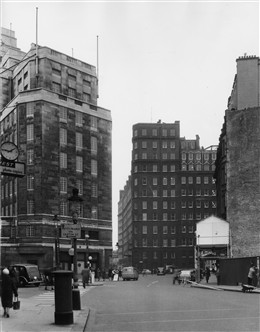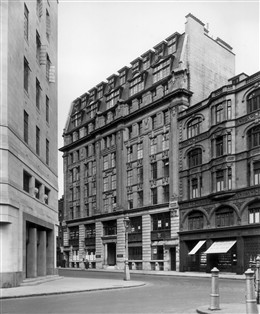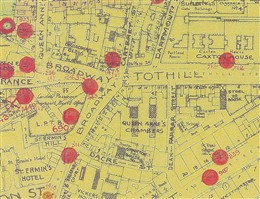55 Broadway SW1

55 Broadway SW1
Copyright Westminster City Archives

55 Broadway SW1 (54 Broadway offices of SIS at centre of page)
Copyright Westminster City Archives

Bomb Map: 55 Broadway SW1
Copyright Westminster City Archives
14 October 1940
By Ronan Thomas
55 Broadway, a 174ft-high Art Deco office complex, was designed by architect Charles Holden and built between 1927-1929. A slice of Jazz-Age Chicago, it was decorated with elemental sculptures by Eric Gill, Henry Moore, Jacob Epstein and Eric Aumonier. It was popularly known as ‘London’s first skyscraper’.
The building was constructed directly over St James’s Park Underground Station (opened 1868, completed 1927-1929) with an interior embellished with marble passageways and bronze fittings.
Its clock tower and roof terrace offered panoramic views over Westminster including Petty France, Christ Church Broadway (1843), the St Ermin’s Hotel (1899) on Caxton Street, Wellington Barracks and Queen Anne’s Gate.
In 1940 it housed the combined head offices of the London Passenger Transport Board (Underground Electric Railway), the Metropolitan District Railway Company and the London General Omnibus Company.
Directly opposite, at 54 Broadway, were the offices of the Secret Intelligence Service (SIS), later MI6 (operational from 1926-1964). From this address, Churchill's Assistant Director of Intelligence and MI6 principal scientific advisor, Dr R.V.Jones, devised counter-measures to disrupt German bomber radio navigation aids during 1940-1941 and led deception efforts in the V-Weapons campaign of June 1944 to March 1945.
On 14 October 1940, 55 Broadway received a direct hit from a high explosive bomb.
According to London Passenger Transport Board records:
“The bomb penetrated a small section of roof of the West Wing on the 9th floor, passing through successive floors down to the 5th floor, where it struck a steel girder and exploded” (LPTB meeting minute 2295, Appendix 19, 7 November 1940, courtesy TfL Archives).
A fire broke out and a sizeable section of the upper West Wing was gutted. No casualties were reported among London Transport staff but the building’s Portland Stone facade and sections of its interior were badly damaged.
One floor level collapsed downwards and debris fell into Broadway. Photographers from the Topical Press Agency captured views of mangled offices exposed to the open air on the morning of 16 October.
14-15 October 1940 was a bad night for London Transport. At around 8pm on 14 October a 1,400kg bomb hit Balham Underground Station SW12 (Northern Line) killing 68 shelterers. By war’s end in 1945, London Transport had reported a total of 9,000 separate damage incidents across the capital and the deaths of 181 members of staff.
City of Westminster buildings also damaged that evening included Church House, St James’s Church, Piccadilly, the Carlton Club, Pall Mall, the Treasury Gardens, 10 Downing Street and Lowndes Street SW1.
In the wake of the attack, emergency repairs were made to 55 Broadway and it remained in service as London Transport's strategic and operational management hub.
The east entrance was also later damaged and incendiaries fell on and around the building on 10-11 May 1941. Another bomb struck adjacent offices on Petty France.
Major restoration to the smashed West Wing portion was subsequently completed by contractors Holland & Cubitts Ltd and Rubery Owen & Co Ltd, so successfully that today no trace of its wartime damage is visible.
This Westminster landmark continues in use as the Head Office of London Underground Limited (formed 1985) as well as featuring a bustling ground level of shops and cafes.